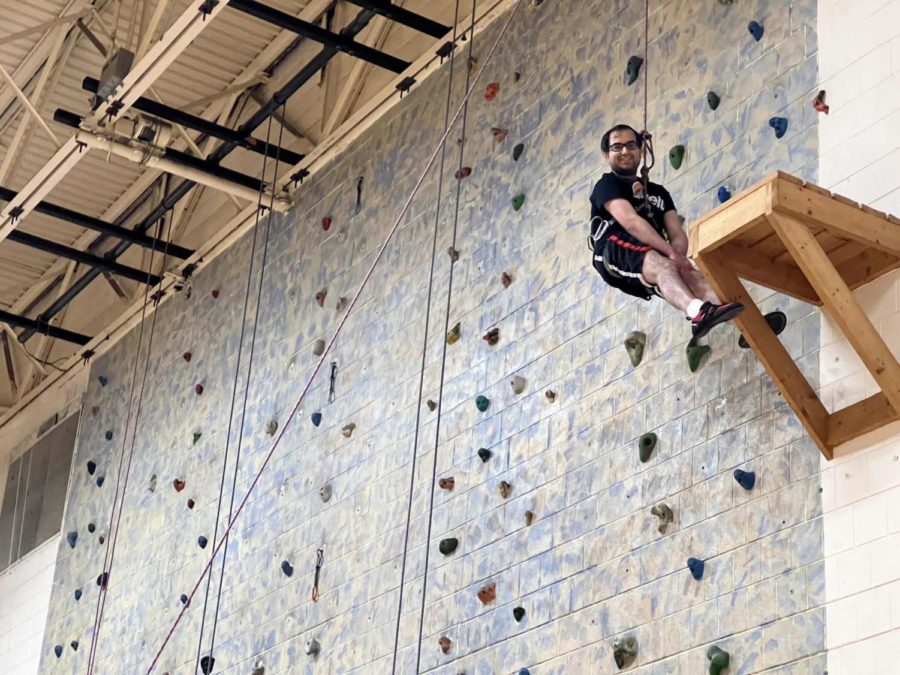Rock-Climbing Is Like Playing A Platforming Adventure Video Game
November 1, 2022
NEIU Campus Recreation hosts open climbing sessions on Thursdays from 2 – 4 p.m. in the Auxiliary Gymnasium of the Physical Education Complex. NEIU has a monolithic and vertical rock-climbing wall that comprises five lanes, and each lane has varying degrees of challenges. It is reminiscent of video games that may have easy, normal, expert and super expert levels of difficulty. There are several genres of video games, such as action, adventure, simulation, sports, speed runs, melee, platforming, puzzles and so many others. Rock-climbing takes concepts from each of these genres to be a multi-genre sport. Keith Zhan, age 24, Graduate Assistant in Exercise Science, says climbing is like doing a “relaxing physical puzzle.” On the topic of relaxation, Jon Scott-Haines, age 37, Undergraduate Student in Biology, has stated, “I think I enjoy the meditative or euphoric state of being exposed” while climbing rocks. On that thought, the practice of meditation is about clearing one’s mind to find peace. Haines said “I generally have no thought at all [while climbing] except thinking about my moves, [and] after I get down, I think about the extent of what I have done.”
Some climbers may have discovered the art of climbing during childhood, such as Haines, and others may have found their love of climbing during adulthood, such as Zhan. On one hand, Haines said, “since I was a kid, I was mischievous about climbing trees, but as a sport, I started rock-climbing about eight years ago.” As a kid, Haines has stated that he enjoyed “scrambling around in the trees.” On the other hand, Zhan started climbing two and a half years ago in his home state of Oregon and continued the climbing lifestyle here in Illinois. Generally, as a child, Zhan established the habit of “just [going to] school and back home” on a daily basis. Zhan admits to being “inactive as a child,” and he did “chess club in high school.” As you can see, chess and climbing may seem like complete opposite activities, but in fact, they both deal with plotting the next move strategically. For instance, a wrong current move may prevent a much improved upcoming move. For example, while in the midst of a climb, Zhan often thinks to himself “should I try this move or this [other] move” as well as considering “what move should I do next?” Thus, Zhan is sufficiently diverse to dabble in both chess and rock-climbing.
Despite climbing being an active and adventurous activity, there are some practical reasons that people do not climb regardless of the desire to climb. Zhan discussed that the biggest issues to start the practice of rock-climbing in a new place is “accessibility and cost,” and these two factors have “inhibited people [from climbing] because it is usually $28 for a day pass.” Thankfully, the campus recreation facility offers this surprisingly costly activity free to all students.
Campus recreation has all the necessary safety equipment for students and community members to use while climbing. Harnesses, climbing shoes, ropes, Gri Gris, carabiners, chalk bags and helmets are the utilized equipment for making safe climbs and descents.
I personally helped to test the routes, reconfigured the routes and chose new rocks to mount on the wall. My personal favorite route is the far-right lane. I have climbed it and reached the bell at the top at least five times. I ended up climbing it faster each subsequent attempt. I am currently trying to speed climb this particular route much like speed running a level of a video game. The strategy is knowing and memorizing which rocks are optimal to use for strong footholds and tenacious hand grips.
When designing a new route, it should be challenging, but not so off-putting that it elicits people rejecting the challenge. All things in life require a balance of sorts. It should not be so easy that the feeling of triumph does not feel earned, but it should not be so difficult that a prospective climber refuses the challenge to begin with.
There is a common misconception among novice climbers and non-climbers. It is often assumed that one must have above average upper body strength. Fortunately for me, this sentiment is untrue. Most of the strength required for climbing is in the legs by appropriately flexing and extending the leg muscles. While the climber climbs, the belayer continuously keeps the climber safe at all times. The belayer is the person who handles the rope on the ground and tightens it by removing slack from the rope as the climber gets higher.
The rope meets the climber’s harness above the pelvic bone position, which is the anatomical location that the harness rests on. Thus, the climber becomes reliant on the harness, rope and leg muscles to do the lifting. The hands and arms are for reaching and doing some mild pulling and gripping. It is important to keep these tactics of climbing in mind in order to climb smarter and not harder.
When I climb, it feels like I am one of the Mario Bros., and I must sometimes “send it” further and faster on the route. “Sending it” is a type of rock-climbing terminology that means attempting to finish a climb or achieving a new position while not giving up. It feels like living in a video game, and the safety gear is an infinite save-state or checkpoint system that helps to give confidence on the way up. On one hand, some climbers prefer the ropes to be ultra-tight in order to not feel a drop of any height. On the other hand, some climbers prefer a slight drop of two to three feet in order to redo a failed ascent. Nevertheless, the premise is to feel good at achieving a new height.
The act of climbing and modifying the climbing route is identical to Nintendo’s Mario Maker series of video games because there are both players and makers of levels. When making a level, it is imperative that challenges are created for prospective players to overcome. Making a level and designing a climbing route are analogous. Haines has agreed on the subject of challenging routes by stating, “I think it feels good to create a problem for someone” to solve.
For those not familiar with these video games, rock-climbing may also be comparable to Bennett Foddy’s ‘Getting Over It’ video game available on Steam, and this video game represents a failed ascent by falling to a threshold much further below, and the player is required to get a grip on the piles of materials and then try to keep climbing on the piles of random materials.
The lasting sentiment of ‘Getting Over It’ is that if your hands or feet slip, and you drop, it is not the end of the world because if you did something once, you can definitely do it again. Furthermore, once you get to a certain spot on the wall once, you are more than capable of doing it again. However, unlike the aforementioned checkpoint and save-state system of safety, ‘Getting Over It’ has none. Thus, playing Mario Bros. on emulators or in the Mario Maker series may be more representative of rock climbing.
The purpose of this rock-climbing wall is to simulate outdoor rock climbing without the threats of the crazy variables in the wild, such as the wind, animals, sharp or jagged rocks, loose rocks or uneven terrain. Thus, the safety protocols give the sense of a video game emulator with as many save states as possible. The safety protocols of belaying are very analogous to the save-states and checkpoints found in video games.
Watching video games being played or watching a climber may appeal to a sadistic sense of humor. Haines concurs with this sentiment by admitting that “it is a little bit sadistic to watch someone struggle, but [it] feels rewarding to see them overcome the challenge.”
Upon my first attempt on the rock wall, I found a gap in the route where I had to jump to reach a higher rock. Thus, I found a nice large rock to aid in the ascent, and Haines mounted it up. I climbed it again, and it felt more comfortable, but I wanted to add something else to get the climber to think a bit. Thus, I chose a very tiny rock that the climber sees before the nice large rock to troll the climber. Haines added the troll to the wall.
I climbed the wall again. It felt like a troll level from the Mario Maker Series of video games. I liked it because it forces the climber to pause for a moment and reevaluate their ascent. The climber can either use the pathetically small rock or ignore it and reach or jump for the nice, big and comfortable rock. Thus, there are multiple routes that the climber may use when climbing the wall.
When designing a level in a video game, there are often inadvertent and unplanned routes that may exist in a level. Climbing routes often have the same problem. Zhan has affirmed that designing climbing routes is “frustrating because there is always a loophole” which is like an “unintended climbing maneuver [that is] used.” Sometimes the consequence of being a little taller, shorter, or having longer or shorter arm spans is not a consideration that a climbing route designer has planned.
When I am not climbing, I enjoy belaying other climbers to get to new heights. Belaying is the act of fastening and tightening the rope while using the safety gear to prevent drops and falls. I like being in charge of the safety of others. Being a public health major, I have recognized that occupational safety is an imperative component of the field. Safety is quite a noble profession because it ensures that people can do what they want to do without the fear of hazards or threats to their lifestyle. In its essence, they can continue living after doing a seemingly dangerous activity.
When taking part in the art of climbing and belaying, it is important to recognize the value of communication between the climber and belayer. For example, we have certain commands that verify that belay is on and climbing can proceed. In addition, in the midst of a climb, the climber may ask for help if they do not realize which rocks to place which foot or hand on. The belayer should understand and empathize the matter by also being a climber as well. The belayer should give responses of good strategies by saying to place a particular hand or foot on a particular-colored rock. At the end of an ascent, the belayer would have the ideal amount of tightness on the rope for mistaken slips on the climber’s part, but it is a great habit for the climber to tell the belayer when he/she is ready to descend. Upon descent, the climber would let go of the wall and ideally kick the wall on the way down. Communication is key between the climber and belayer.
For students and community members who have discomfort with heights, there is a bouldering wall. In its essence, the bouldering wall is a horizontal wall no higher than a meter off the ground. Blue mats are set parallel to the bouldering wall. There are falling techniques that should be utilized to make the drop more comfortable. For example, the boulder climber should unintuitively release the hands first by pushing the wall, and then letting their feet fall back while rolling on the blue mat, which is similar to a backwards somersault motion. The intuitive approach is to let the feet and hands go and jump down, but that allows the knees to feel a slight shock. Thus, the unintuitive approach is more optimal. Personally, I find it very unintuitive to do the drop off the bouldering wall, and I prefer being reliant on the safety gear of the vertical rock lanes because I can do the climbing and then let go of the wall with no impact on my body.
Speaking of the descent, the descent of the vertical wall is the most fun part for me because it feels like I am on the triage rescue unit to give aid to people from a helicopter. However, the only way to feel this remarkable and triumphant emotion is to first do the ascent.
Regardless of your experience with rock climbing, you should definitely try out the sport. According to Caber & Albayrak, in a paper titled “Push or Pull? Identifying Rock Climbing Tourists’ Motivations,” the researchers discovered that low experienced climbers tend to achieve the motivation to try climbing by seeking risk taking activities, challenges, novel experiences, innovative climbing infrastructure and aloofness. By the same token, the highly experienced climbers were most satisfied with their rock climbs after experiencing the physical attributes, challenges and release of emotional tensions. As you can see, rock climbing is an experience that can be enjoyed by climbers of all experience levels whether you have never done it before or climbed hundreds of times in the past. From my perspective, the “belay is on,” and you should definitely “climb on!”
External sources:
Caber, M. & Albayrak, T. (2016). Push or Pull? Identifying Rock Climbing Tourists’ Motivations. Tourism Management, 55(2), 74-84. https://www.doi.org/10.1016/j.tourman.2016.02.003







